A lively boyhood in a musical milieu.
Douglas, the capital of the Isle of Man, was a holiday mecca in Victorian times for people from Northern England. Even before Haydn Wood was born, his family had regularly journeyed there from Slaithwaite, Yorkshire. At the beginning of the 1885 tourist season, Haydn's brother Harry, a precocious and entrepreneurial young violinist of 17, was hired as leader and soloist of the large orchestra at the Falcon Cliff Castle in Douglas. That summer, Sabra Wood brought daughters Mary Hannah, Sophia, Adeline and Eliza and her little son Haydn, age 3, to proudly watch and listen to Harry and the orchestra.

Little Haydn with his sister Sophia.
Later that same year, leaving the running of their Lewisham Hotel and Pub in Slaithwaite to Mary Hannah and her husband, Sabra and Clement Wood settled in Douglas with their six younger children. They chose as their family home the Black Lion Hotel on the North Quay, where they carried on their lifestyle as innkeepers. They had all hoped that the sea air would help cure Clement's failing health. However, Clement died at the hotel a year or so later, on 22 December 1886, at age 53.
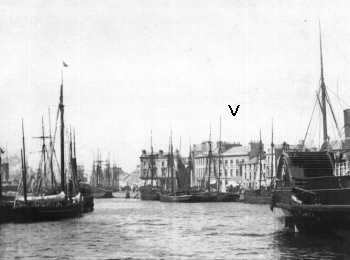
The marker points to the Black Lion Hotel on the North Quay, Douglas.
Sabra took over the Black Lion. The family remained at this waterfront hotel and boisterous pub until February 1889, when they moved to 17 Albert Street, also in Douglas. Young Haydn, age 9 or 10, penned this Albert Street address at the top of the cover of his manuscript music book No. 3. This book contains some of his early composition sketches, such as his Evia Valse.
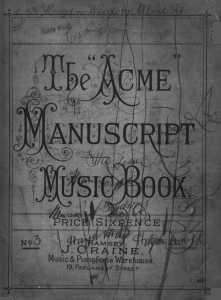
Haydn is known to have attended the Tynwald Street School for Boys and the Douglas High School for Girls, a private school at 33 Derby Square run by the Misses Green. Years later he recollected: 'During the first term I played truant for three weeks before I was found out. The ladies who ran the school eventually called on my mother one morning to ask the reason for my absence. No one was more surprised than my dear mother because I had turned up regularly for my mid-day meal during that period. I used to spend most of my time in a fruit garden on the fringe of town, but later became bolder and ventured into town.'
From about the age of 7, Haydn studied the violin with his brother Harry, who would have been by then 21 years old. Harry was a kindly and excellent violin teacher (half a dozen of his students are known to have won places at the Royal Academy of Music and the Royal College of Music in London). Haydn loved playing, and learnt fast. He loved being a member of Harry's Students Orchestra, but not a soloist: 'My earliest recollection is appearing at innumerable charity and parochial tea-concerts... How I hated to be greeted on coming home from school by my mother telling me that So-and-so had called and wished me to play at this or that concert... This was the signal for tears.' And yet he was soon consumed with a burning ambition to succeed as a concert violinist.
Harry Wood, later known as Manxland's King of Music, enthused that with his five concurrent orchestras for concerts and dances, in the summer seasons his employers sold approximately 50,000 tickets to the merrymakers every week! Young Haydn - and other members of the Wood family such as Daniel, one of the most brilliant classical flautists of his day - reaped the benefits of all this. From age 10, Haydn gained regular solo and orchestral experience playing an hour or so each afternoon and evening with Harry's orchestras at the Derby Castle. On top of this, he played in Harry's Orchestral and Operatic Concerts at the Grand Theatre.

In1896, fourteen-year-old Haydn moved to London for further advanced studies in violin. Within a year he entered the Royal College of Music for six years of full scholarships. About January 1897, his widowed mother and siblings moved to 1 Marathon Terrace in Douglas. Haydn returned from London regularly, as is sentimentally described by John Sugden in his book Slaithwaite Notes: 'Let me say that not only the sons of the late Mr. Clement Wood are born musicians, but the daughters are naturally clever, though the most pleasing feature in the family is the dear old mother (now in Douglas) and her youngest son, Haydn, when this prize of her old age comes home from his studies in London, the meeting is most touching and tender, being very creditable to both.' Sabra died in Slaithwaite on 19 June 1902. Both of Haydn's parents, Clement and Sabra Wood, are buried at Kirk Braddan Cemetery, Douglas, Isle of Man.

Marathon Terrace on the Queen's Promenade.
During his visits to his mother, Haydn played in Harry's orchestras at the Palace and at the Gaiety Theatre, where he was again featured as solo violinist. In November 1902, he led the orchestra in the extravaganza King Gobnageay at the Gaiety Theatre. After graduating from the College in April 1903, he returned that summer as leader and deputy conductor of Harry's Sunday Evening Concerts at the Palace. He again led the orchestra at the Gaiety in 1904, in a Children's Fairy Extravaganza, Babes in the Wood (From a Manx Point of View), produced by Music Director Harry Wood. The boys' sister Adeline was fully involved in both these extravaganzas; she invented the dances, organized the costumes, and had singing and acting roles as well.
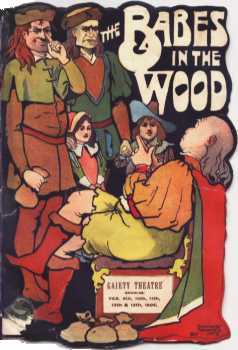
The wanderer crosses the main.
In 1909, Haydn Wood married Savoyard soprano Dorothy Court and the couple were based in London for the rest of their lives. Starting in 1913, they embarked on twelve successful years of touring the variety halls through the British Isles. Their act played at the Palace and the Derby Castle in Douglas during the summer seasons except during the war years when these venues were occupied by the government departments.
According to the 1911 census, Harry and Adeline had moved to 1 Osborne Terrace, where Haydn and Dorothy stayed when they returned to the island to visit and concertize throughout the 1920s and 1930s. Haydn enjoyed fishing, golfing and country rambles, and passionately talking cricket with Harry.
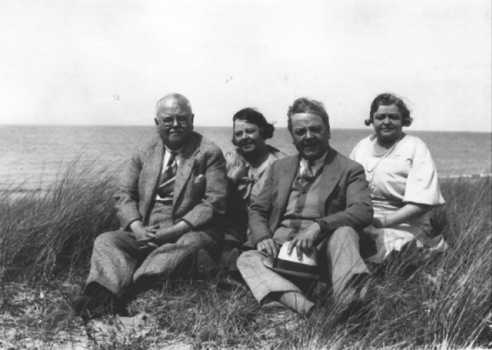
From left to right: Harry, Adeline, Haydn and Dorothy, in 1934.
By the late 1920s, Haydn Wood was becoming known as a conductor of his own music, and he conducted concerts at the Palace from then on and throughout the 1930s. On 19 June 1927, in a huge Manx Celtic Concert in which Harry was greatly involved, he conducted the Palace Orchestra in A Health to All Who Cross the Main for baritone, chorus and orchestra, with lyrics by Manxman Henry Hanby Hay, which he had composed expressly for the Manx Home-coming Celebration.
Douglas audiences were treated to two Haydn Wood concerts, on 22 July 1928, and on 17 August 1930. Haydn and Harry took turns at the podium in conducting the Palace Orchestra in some of Haydn's orchestral works. He also played virtuoso violin solos with piano accompaniment. Soprano, tenor and baritone soloists sang selections of his popular songs, some featuring Haydn playing violin obbligatos or accompaniments on the piano. A lullaby, The Fairy Changeling, with lyrics by Henry Hanby Hay, was premiered in the 1928 concert.
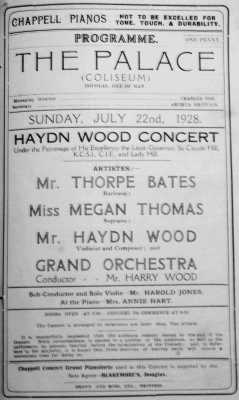
It was not until 1931 that Haydn Wood started composing his large scale Manx orchestral pieces. The first of these to be played in Douglas was Mannin Veen, on 9 July 1933, conducted by the composer in an exciting concert which included the second and third movements of his new Concerto for Violin, performed by the Spanish violinist, Antonio Brosa with the Palace Grand Orchestra.
The next time Haydn and Dorothy made news with their arrival in Douglas was 26 January 1938, when they came for a short golfing holiday and to attend the annual dinner at the Ellan Vannin Club on 29 January. Harry was elected the president of the club that year. At this dinner, Hilton Cullerne - Harry and Haydn's nephew and violin student whilst a boy on the Isle of Man - performed two of Haydn's compositions for violin, Slumber Song and Elfin Dance, accompanied by the composer on the piano.
Haydn Wood's Lochinvar for chorus and orchestra, with text by Sir Walter Scott, was the climactic concert piece at the Palace on 27 April 1939, the last evening of the Manx Music Festival. Lochinvar was sung by the combined Choral Classes and conducted by Haydn Wood, who received a tremendous ovation from the audience.
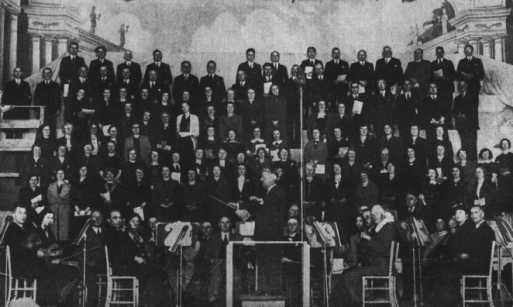
Lochinvar was broadcast by the BBC, as witnessed by the tall microphone stand to HaydnWood's right.
Sister Sophia had died in Douglas in 1929, and Harry died on Christmas Day 1938, when on holiday visiting his sister Eliza in Golcar, Yorkshire. Because of the war, April 1939 was the last time that Haydn was able to get to the island until 1947. Adeline must have felt extremely vulnerable when their Osborne Terrace home was taken over by the military in World War Two. Her move to live with her sister Eliza in Golcar meant the end of the Wood family residing on the Isle of Man.
Following the success of Lochinvar in 1939, Haydn Wood was inspired to compose another grandiose work for chorus and orchestra, Ode to Genius, which was intended for the Manx Music Festival Golden Jubilee of 1940. But because of the war, Ode to Genius was not programmed until the second Victory Guild concert of 1946. Although Haydn was expected to be on the podium at the Gaiety Theatre, circumstances meant that he didn't make the trip to the island.
When at last Haydn and Dorothy made the crossing on 30 April 1947, they must have felt very happy; it was for the conference of Rotary International in Great Britain and Ireland (R.I.B.I.), with its 4,500 delegates. He was given free rein to choose some of his favourite compositions for the conference's orchestral, choral and vocal concert at the Palace on 4 May 1947. He conducted A Manx Rhapsody, Torch of Freedom, Mannin Veen, Manx Countryside Sketches, and Ode to Genius. The vocal solos included one of his own songs, I Bended Unto Me a Bough of May, with whimsical lyrics by Manx poet T. E. Brown.
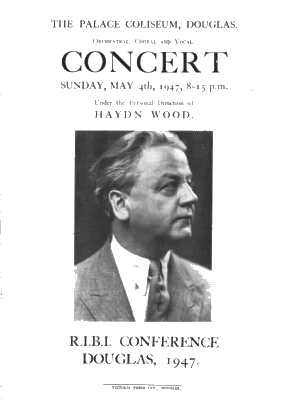
'Haydn is still full of composionitis.' (Dorothy Court, 26 June 1947)
Haydn Wood was facile at composing in a vast range of genres, from concertos to music hall hits. Though he never again resided permanently on the Isle of Man after age 15, he continued his intimate connection with a Manx way of life, and found inspiration for some of his compositions from Manx folk melodies, lyrics and legends. No records have survived to prove that Haydn noted down traditional Manx tunes from informants, except for a variant of the Rushen Funeral Hymn which he collected from parish clerk Evan Qualtrough some time before 1936. Several of his approximately 80 orchestral works include themes taken from Manx folk songs and legends, and a few are his own Manx-inspired creations. Even his A May-Day Overture (1918) may have been inspired by Gaelic celebrations held always around the first of May, albeit Haydn Wood's first title penned on the manuscript was A Rustic Overture. The following are the titles of Haydn Wood's Manx orchestral compositions:
A Manx Rhapsody (1931).
Mannin Veen, Dear Isle of Man, A Manx Tone Poem (1933).
A Manx Overture, The Isle of Mountains and Glens (1937).
King Orry (1939).
Manx Countryside Sketches (1943).
Mylecharane, Rhapsody (1946).
A Pageant of the Isle of Man (1951).
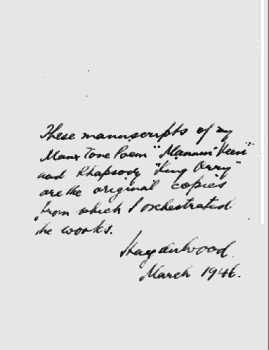

The piano conductor of King Orry, with the working surtitle The Land of Mystic Shadows on the Hills crossed out.
On the occasion of the first BBC broadcast in February 1933 of Mannin Veg Veen, Haydn Wood was quoted as saying to the Isle of Man Times: 'The critics were struck by the beauty of the national airs. I feel very proud and gratified that our tunes are so appreciated… It was my original intention to call the work Mannin Veg Veen (Dear Little Isle of Man) but I found that people would insist on pronouncing "veg" as a waiter does in a cheap restaurant when he bawls down the lift for "meat and a couple of veg." I decided to abandon the "potatoes and peas" portion of the title.'
Throughout his life, Haydn Wood wrote the music for about 200 songs and ballads; here follows the complete list of his songs with lyrics by Manx poets:
Henry Hanby Hay: Cupid's Hunt (1907).
Cushag (Josephine Kermode): The Phynodderee (1909),
written expressly for the Manx Festival of 1910 and dedicated to
Mrs. Laughton of Peel.
Henry Hanby Hay: A Health to All Who Cross the Main
(1927), composed expressly for the Manx Homecomers' Celebration,
June 1927.
Henry Hanby Hay: The Fairy Changeling, Lullaby (1930).
Philip W. Caine: The End of the World (A Manx Spiritual)
(1934).
Richard Corrin: A Thousand Beautiful Things (1946).
T.E. Brown: I Bended Unto Me a Bough of May (1947).
Richard Corrin: Song of a Thankful Heart (1948).
W. H. Gill: Mylecharane, A Manx Folk Song for Baritone
and Orchestra (1948).
Marie Rose Martin: A Song of Devotion (1949).
Richard Corrin: As I Go on My Way (1950).
Marie Rose Martin: Remember Me (1951).
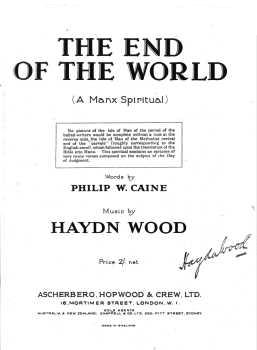
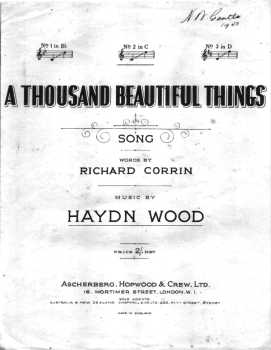
When a young man in his twenties, Haydn Wood wrote the lyrics for six of his own songs under the pseudonym Hilton Schofield. All these lyrics have youthful, bucolic themes, possibly inspired by his life on the Isle of Man: Spring-time (1905), On a Spring Morning (1909), The Frog's Lament (1912), Fickle Fortune (1912), A Breezy Ballad (1912), and Wings of Morning (1914). Here are excerpts from On a Spring Morning:
|
Hey nonny no, |
Perhaps he would have written more on Manx texts - those of his own or others; but his London publishers plied him with lyrics by poets of their choosing.
From 14 to 18 February 1939, the Douglas Gas Light Company produced a state-of-the-art exhibition to sell more gas by bringing before the public labour-saving gas appliances and cookery demonstrations. It was held in Douglas at the Palais-de-Danse. From all accounts the whole event was a resounding success. A colourful pageant presented in song, dialogue and striking scenes the story of the development of science through the ages. There were seven scenes in all, including the Cavalcade of Creation and the Cavalcade of the Sea especially composed by Haydn Wood, and the Cavalcade of Coal composed by his brother Harry. The accompaniment was provided by a small pit orchestra called the Industrial Band.
Celebration of the Manx.
Tynwald Day, 5 July, is the National Day of the Isle of Man. On 5 July 1926, BBC Manchester broadcast 'A Programme of Manx Music and Folklore'. On 5 July 1931, BBC National broadcast a concert from the Palace in Douglas called 'A Celtic Congress Programme' which included Haydn Wood's A Manx Rhapsody. And on 5 July 1942, there was a programme of a special BBC recording titled 'Music for Tynwald Day'. To Haydn Wood, these radio celebrations of Manx music spread over seventeen years were not enough. He wrote constantly and to no avail from 1944 through 1950 to encourage the BBC to broadcast his and other Manxmen's music, saying: 'No other composer has tried to further the cause of Manx folk music as much as I have and I cannot help feeling that if some of my contemporaries had taken the same interest in it the BBC would have looked out with a kindlier eye on my proposal.' Finally, success: on 5 July 1951: his two Manx Country Sketches were broadcast in a concert for the 'Music at Tea Time' programme. The highest point was on 5 July 1952: the BBC Opera Orchestra, conducted by Stanford Robinson, played Mannin Veen, plus the BBC Northern Orchestra, conducted by Haydn Wood, played a whole concert of his compositions in a programme called 'Music for Tynwald Day.' These were the final broadcasts of Manx music on Tynwald Day during Haydn Wood's lifetime.
Haydn Wood's last contribution to the Manx music repertoire came about when he was asked to write the music for the 1951 Isle of Man Festival of Britain Pageant with libretto written by English author and playwright Lawrence du Garde Peach. The pageant was a mammoth undertaking for hundreds of actors, dancers and musicians, including vocal soloists, chorus and orchestra. Haydn Wood spent months composing new music for 23 out of the 31 numbers. With his wife Dorothy, he attended all the shows, which took place at Ramsey, Peel, Castletown and Douglas over the period from 19 June through 3 July.
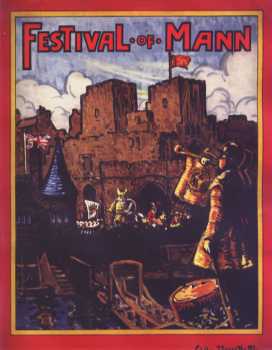
Harry and Haydn Wood arrived in the Isle of Man at a time when anglicizing of the culture was pervading the island. The boys were in the forefront of what was new; they were a big part of the limelight glare of the dance and concert halls whose excitement had taken the place of the lighting of ancient Baal fires on the mountains. Yet they both loved the old ways of their island, and tried quite successfully to preserve and propagate its traditional music.
On the occasion of the 50th anniversary of the death of Haydn Wood, a grand concert took place at the Villa Marina, Douglas, on 22 November 2009. The evening, compèred by Charles Guard of the Manx Heritage Foundation, revived memories of the Wood brothers' musical legacy. The Isle of Man Symphony Orchestra, Island Choirs and soloists, conducted by Maurice Powell, played compositions of all three brothers - Haydn, Harry and Daniel. In the Souvenir Programme, Dr. Breesha Maddrell wrote: 'Haydn Wood's arrangements of Manx traditional songs and melodies do them great justice - he explores their twists and turns with charm and ease, developing and linking them with sensitivity and respect.'
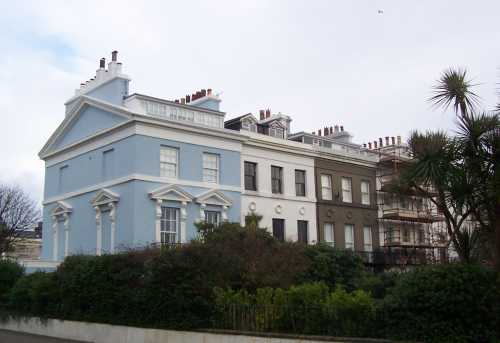
1 Osborne Terrace (blue house), the only Wood residence in Douglas that remains today.